NCERT Class 8 Social Science Chapter 12 Indian After Independence Solutions to each chapter is provided in the list so that you can easily browse through different chapters NCERT Class 8 Social Science Chapter 12 Indian After Independence and select need one. NCERT Class 8 Social Science Chapter 12 Indian After Independence and After Question Answers Download PDF. NCERT SST Class 8 Solutions.
NCERT Class 8 Social Science Chapter 12 Indian After Independence
Also, you can read the NCERT book online in these sections Solutions by Expert Teachers as per Central Board of Secondary Education (CBSE) Book guidelines. CBSE Class 8 Social Science Solutions are part of All Subject Solutions. Here we have given NCERT Class 8 Social Science Chapter 12 Indian After Independence and After, NCERT Class 8 Social Science Textbook of Our Pasts – III: History, Social and Political Life – III: Civics, Resources, and Development: Geography. for All Chapters, You can practice these here.
Indian After Independence
Chapter: 12
OUR PASTS – III [HISTORY PART – II]
NCERT TEXTBOOK QUESTIONS
LET’S IMAGINE
You are witness to an argument between an adivasi and a person who is opposed to the reservation of seats and jobs. What might be the arguments you heard each of them put forward? Act out the conversation.
Ans. Argument of a person who is opposed to the reservation:
1. Reservation is against the spirit of equality.
2. It checks the chances of admission of more intelligent students in the educational in situations.
3. Reservation in a sort of punishment for present generation of general category, who is not responsible for this miserable socio-economic back wardness.
4. Reservation will provide lesser intelligent teachers, doctors, officials and India will go back or will remain backward country in the era of global competition.
Arguments of Adivasi:
1. We are the real inhabitants of this country.
2. We have been exploited since generations by peoples of plains or out siders-especially merchants, money-lenders, king mafia, foreign companies, exploiters or greedy employers.
3. We have been kept backward in the field of education, health services, latest knowledge, etc.
4. We will progress quickly with the help of reservation. Due to reservation we will have more effective voice in legislature and in the parliament of the country. We will be in better form to compel the authorities of the country to listen our grievance.
LET’S RECALL
Q.1. Name three problems that the newly independent nation of India faced.
Ans. Three problems that the newly independent nation of India faced were:
(a) As a result of partition, eight million refugees had come into the country from what was now Pakistan. These people had to be found homes and jobs.
(b) Second, was the problem of the princely states, almost 500 of them, each ruled by a Maharaja or a Nawab, each of them had to be persuaded to join the new nation.
(c) In the longer term, the new nation had to adopt a political system that would best serve the hopes and expectations of its population.
Q.2. What was the role of the Planning Commission?
Ans. The government set up the Planning Commission in 1950 for economic development of the country. The main role of the Planning Commission was to Prepare a Plan for the ‘most effective and balanced utilization of the country’s resources’. The Planning Commission was to decide- which industries should be initiated by the state and which by the market, how to achieve a balance between the different regions and states.
0.3. Fill in the blanks:
(a) Subjects that were placed on the Union List were ___________, __________ and __________.
Ans. Taxes, defense, foreign affairs.
(b) Subjects on the Concurrent List were ___________ and __________.
Ans. Forests, agriculture.
(c) Economic Planning by which both the state and private sector played a role in development was called a __________ model.
Ans. Mixed economy.
(d) The death of __________ sparked off such violent protest that the government was forced to give into the demand for the linguistic state of Andhra.
Ans. Potti Sriramulu.
Q.4. State whether true or false:
(a) At independence the majority of Indians lived in villages.
Ans. True.
(b) The Constituent Assembly was made up of members of the Congress Party.
Ans. False.
(c) In the first national election, only men were allowed to vote.
Ans. False.
(d) The Second Five Years Plan focused on the development of heavy industry.
Ans. True.
LETS DISCUSS
Q.5. What did Dr. Ambedkar mean when he said that in politics we will have equality, and in social and economic life we will have inequality.”?
Ans. Dr. B.R. Ambedkar, chairman, of the Drafting Committee pointed out that political equality would have to be accompanied by social and economic equality. He meant that introducing one man one vote will lead to political equality, however in our social and economic structure continue to deny the principle of one man one value.
Q.6. After independence, why was there a reluctance to divide the country on linguistic lines?
Ans. There was a reluctance to divide the country on linguistic lines because:
(a) India had been divided on the basis of religion. Despite the wishes and efforts of Mahatma Gandhi, freedom had to come not to one nation but to two. More than one million people had been killed in riots between Hindus and Muslims. And the country could not afford further divisions on the basis of language.
(b) Both Prime Minister Nehru and Deputy Prime Minister Vallabh Bhai Patel were against the creation of linguistic states. They believed that it was time to keep India strong and united.
Q.7. Give one reason why English continued to be used in India after independence.
Ans. English continued to be used in India after independence because:
(a) Though Hindu was chosen as the national language the use of Hindi was not accepted by the other regions especially the south.
(b) The leaders felt the need for a common language that would link people of different regions.
Q.8. How was the economic development of India visualized in the early decades after Independence?
Ans. (a) In 1950, the government set up a Planning Commission to help design and execute suitable policies for economic development.
(b) The main stress in the First Five Year Plan (1951-1956) was on agricultural development.
(c) The Second First Five Year Plan was formulated in 1956. This focused strongly on the development of heavy industries such as iron and steel and on the building of large dams.
(d) After independence, a number of steps were taken by the government to make the balanced growth of all regions of country.
(e) The development of regions or states have not been same due to multiple kinds of variations and diversities, ethnic divisions, social customs, cultural patterns and religions.
LET’S DO
Q.9. Who was Mira Behn? Find out more about her life and her ideas.
Ans. Mira Behn was a follower of Mahatma Gandhi. She was greatly impressed by the ideals, philosophy and ways of working of Gandhi ji.
Mira Behn worked against caste discrimination, untouchability, in favor of human equality and rights. She emphasized the development of agriculture, cottage industries and education.
Mira Behn emphasized on studying nature’s balance and develop our lives within her laws, as if we are to survive as a physically healthy and morally decent species.
Q.10 Find out more about the language divisions in Pakistan that led to the creation of new nation of Bangladesh. How did Bangladesh achieve independence from Pakistan?
Ans. (a) There are many languages spoken and used in Pakistan Urdu, Persian, Punjabi, Bangle, Pashto, English, Sindhi, etc., are main among them.
(b) After Partition of India on 14th August, 1947, there were two main geographical divisions of Pakistan-West Pakistan (today’sPakistan) and East Pakistan (today’s Bangladesh)
(c) Bangladesh (East Pakistan) broke up from Pakistan and emerged as independent Bangladesh in 1971 after a bloody war. India helped the people of Bangladesh to achieve their freedom.
SOME OTHER IMPORTANT QUESTIONS FOR EXAMINATION
VERY SHORT TYPE ANSWER ANSWER
Q.1. When did the Indian Constitution come into effect?
Ans. Indian Constitution came into effect on 26 January, 1950.
Q.2. What is universal adult franchise?
Ans. All Indians above the age of 18 would be allowed to vote in state and national elections.
Q.3. Why was universal adult franchise a revolutionary step?
Ans. Universal adult franchise was a revolutionary step for never before had Indians been allowed to choose their own leaders.
Q.4. What does equality before law mean?
Ans. Equality before law means that law grants equality to all citizens regardless of their caste or religious affiliation.
Q.5. Whom did H.J. Khandekar hold responsible for the Harijans being unfit?
Ans. H.J. Khandekar held the upper castes responsible for the Harijans being unfit.
Q.6. Why was Prime Minister Nehru against the creation of linguistic states?
Ans. Prime Minister Nehru was against the creation of linguistic states because he believed that disruptionist tendencies had come to the fore and to check them, the nation had to be strong and united.
Q.7. How did Potti Sriramulu die?
Ans. Potti Sriramulu died fasting for a separate state for Telugu speakers.
Q.8. When and how was the bilingual state of Bombay divided?
Ans. In 1960, the bilingual state of Bombay was divided into separate states for Marathi and Gujarati speakers.
Q.9. How was the state of Punjab divided in 1966?
Ans. The state of Punjab was divided into Punjab and Haryana in 1966, the former for the Punjabi speakers (who were mostly Sikhs), the latter for the rest (who spoke not Punjabi but version of Haryanvi or Hindi).
Q.10. What was the focus of the Second Five Year Plan?
Ans. The focus of the Second Five Year Plan was –
(1) on the development of heavy industries such as iron and steel. and
(2) on the building of large dams.
Q.11. Name five diversities found in India.
Ans. (a) Cultural diversities.
(b) Caste diversities.
(c) Religious diversities.
(d) Food diversities.
(e) Language diversities.
Q.12. Which subjects were included under the Union List?
Ans. The subjects such as taxes, defence and foreign affairs which are the sole responsibility of the center would be included under Union List.
SHORT TYPE QUESTIONS ANSWER
Q.1. On the eve of independence what was the composition of India’s population? What were some main diversities seen at that time?
Ans. India’s population in 1947 was almost 345 million. It was divided between high castes and low castes, between the majority Hindu community and Indians, who practiced other faiths. The citizens of this vast land spoke many different languages, wore many different kinds of dresses, ate different kinds of foods and practiced professions.
Q.2. What was the reactions of the different people towards the focus on industries during Second Five Year Plan?
Ans. The focus on heavy industries had many strong supporters, but also some vocal critics.
(a) Some felt that it had put inadequate emphasis on agriculture.
(b) Others argued that it had neglected primary education.
(c) Still others believed that it had not taken account of the environmental implications of economic policies.
Q.3. What was “mixed economy” model?
Ans. The mixed economy model means:
(a) The “mixed economy “model was that both the state and the private sector would play important and complementary roles in increasing production and generating jobs.
(b) What, specifically, these roles were to be which industries should be initiated by the state and which by the market, how to achieve a balance between the different regions and states was to be defined by the Planning Commission.
Q.4. How did the new state of Andhra come into being?
Ans. The state of Andhra Pradesh came into being in the following manner:
(a) Back in the 1920s, the Indian National Congress had promised that once the country won independence, each major linguistic group would have its own province. However after independence the congress did not take any steps to keep up its promise.
(b) In October 1952 a veteran Gandhian named Potti Sriramulu went on a hunger strike demanding the formation of Andhra State to protect the interests of Telugu speakers.
(c) As the fast went on, it attracted much support. Hartals and bandhs were observed in many towns.
(d) On 15 Dec 1952, 58 days into his fast, Potti died. The protests were so widespread and intense that the central government was forced to give into the demand. Thus on 1 Oct 1953, the new state of Andhra came into being, which subsequently became Andhra Pradesh.
Q.5. What was the basic objective of the foreign policy of Independent India?
Ans. The basic objective of the foreign policy of Independent India was Non- Alignment. The non aligned movement urged countries (including India), not to join either of the two major alliances i.e. the American and Soviet alliances.
LONG TYPE QUESTIONS ANSWER
Q.1. How was it difficult to maintain unity and development go together when India became independent in 1947?
Or
What was the level of development of India at the time of its independence?
Ans. At the time of India’s independence its level of development was very low. It was difficult to maintain unity and development at the same time because India faced many problems such as
(a) At Independence, vast majority of Indians lived in the villages.
(b) Farmers and peasants depended on monsoon for their survival. So did the non farm sector of the rural economy. If the crops failed, barbers, carpenters weavers and other service groups would not get paid for their services.
(c) In the cities, factory workers lived in crowded slums with little access to education or health care.
(d) Thus the new nation had to lift its masses out of poverty by increasing the productivity of agriculture and by promoting new jobs and creating industries.
Q.2. What were the salient features of the Indian Constitution?
Ans. (a) Universal Adult Franchise: All Indians above the age of 18 would be allowed to vote in state and national elections regardless of gender, class or education.
(b) The constitution granted equality before the law to all citizens regardless of their caste or religious affiliate. Under the new constitution, people of all religions could have the same rights as Hindus-the same opportunities as regards jobs in the government or private sector.
(c) It offered special privilege for the poorest and the most disadvantaged Indians. The untouchables, the adivasis or Scheduled Tribes were granted reservation in seats and jobs.
HIGHER ORDER THINKING SKILL
Q.1. What was the status given to Princely states by Indian Independence Act, 1947?
Ans. The Indian Independence Act, 1947 (which had given independence to India) gave all Indian Princely States (their number was nearly 562) independence with the freedom to join India or Pakistan or to declare themselves complete independent as a sovereign state.
Q. 2. Give an account of the successes and failures of India during 62 years of its Independences.
Ans. Successes
(a) Ind a is still united and it is still democratic.
(b) There is a free press as well as an independent judiciary.
(c) “The fact that the people speak different languages or practice different faiths had not come in the way of national unity.
Failures
(a) Deep divisions still persists. Despite constitutional guarantees, the untouchable or as they are now referred to the Dalits, face violence and discrimination. In many parts of rural India, they are not allowed access to water sources, temples, parks and other republic places.
(b) Despite the secular ideals enshrined in the constitution, there have been clashes between different religious groups in many states.
(c) The gulf between the rich and the poor has grown over the years. Some parts of India and some groups of Indians have benefited a great deal from economic development. They live in large houses and dine in expensive, restaurants, send their children to expensive private schools and so on. At the same time, many others continue to live below the poverty line.
Q.3. How have the powers and functions of the center and state governments been divided in the constitution?
Ans. The Indian constitution gives the division of power in the form of three lists, known as the Union List, State List and the Concurrent List.
(a) Union list: with subjects such as taxes, defence and foreign affairs would be the exclusive responsibility of the center.
(b) State list: with subjects such as education and health would be the exclusive responsibility of state governments.
(c) A concurrent list: with subjects such as forest and agriculture, in which both the center and the state government would hove joint responsibility.
VALUE BASED QUESTIONS
Q.1. The Constitution of India guarantees equality to all Indians. But after so many years of Independence, deep divisions still persists in India. Do you agree? Why?
Ans. Yes, despite constitutional guarantees, deep divisions persist:
(a) The untouchables or, as they are now referred to, the Dalits face violence and discrimination. In many parts of rural India, they are not allowed access to water sources, temples, parks and other public places.
(b) Despite the secular ideals enshrined in the Constitution, there have been clashes between different religions groups in many states.
(c) Some groups of Indians have benefited a great deal from economic development. They live in large house, dine in expensive restaurant and their children go to expensive private schools. At the same time, many others continue to live below the poverty line.
OBJECTIVE TYPE QUESTIONS
A. Multiple Choice Questions Tick (Right) the correct option:
1. When did the new state of Andhra came into being?
(a) I November 1953
(b) 1 October 1953
(c) 1 October 1954
(d) 15 August 1952
Ans. (b) 1 October 1953
2. When was the bilingual state of Bombay divided?
(a) 1950
(b) 1955
(c) 1960
(d) 1958
Ans. (c) 1960
3. When was a state ceased to be a princely state?
(a) When its prince agreed to merger with India or Pakistan.
(b) When the prince was defeated.
(c) Both (a) and (b).
(d) None of the above.
And. (c) Both (a) and (b).
4. In 1966, the state of Punjab was divided into __________ and __________.
(a) Delhi and Punjab.
(b) Punjab and Haryana.
(c) Punjab and Chandigarh.
(d) Chandigarh and Haryana.
Ans. (b) Punjab and Haryana.
5. When was the Second Five Year Plan formulated?
(a) 1950
(b) 1946
(c) 1956
(d) 1952
Ans. (c) 1956
6. Which subjects were included under Concurrent List?
(a) Forest.
(b) Agriculture.
(c) Both (a) and (b).
(d) Education.
Ans. (c) Both (a) and (b).
B. Fill in the crossword with the help of clues given:
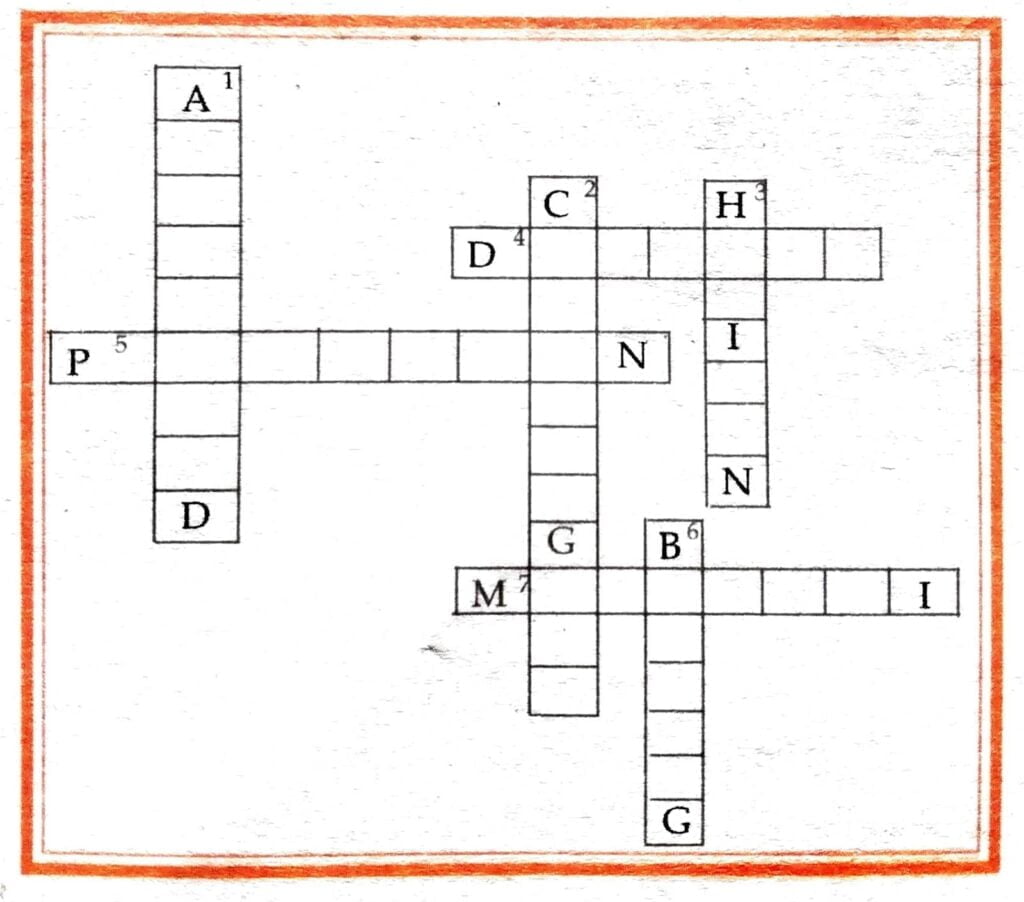
Down:
1. Mahatma Gandhi’s ashes were immersed here.
2. The Bhilai steel plant is located in the backward rural areas of __________.
3. Untouchables are known like this.
6. The leaders of Asian and African countries in the adjoining picture meet at ____________ Indonesia in 1955.

Across:
4. The picture given below shows one of the world’s largest slums in ____________ in Mumbai.
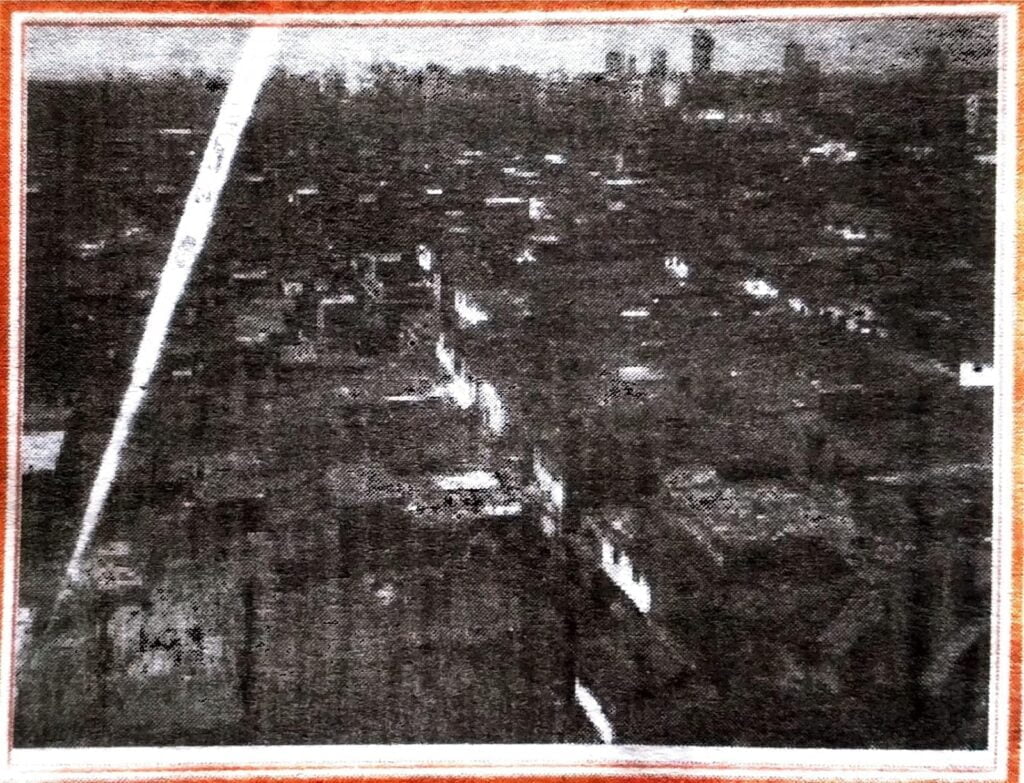
5. A country created explicitly to protect and further the interests of a particular religious community-the Muslims.
7. The bridge shown in the picture given below is:
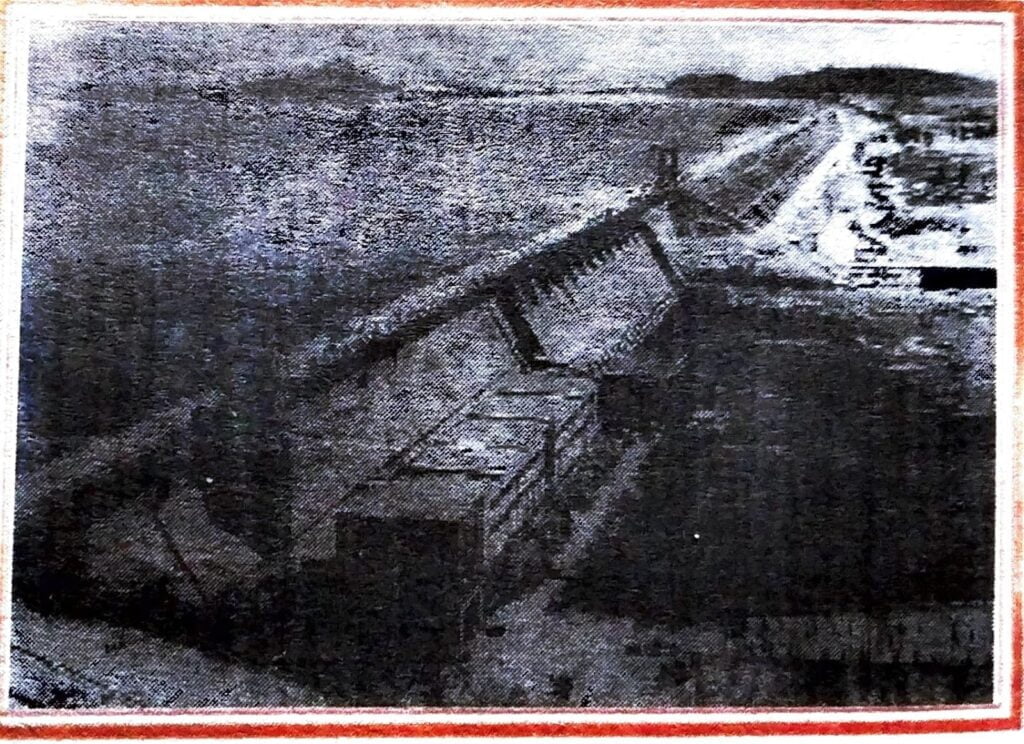
Ans.
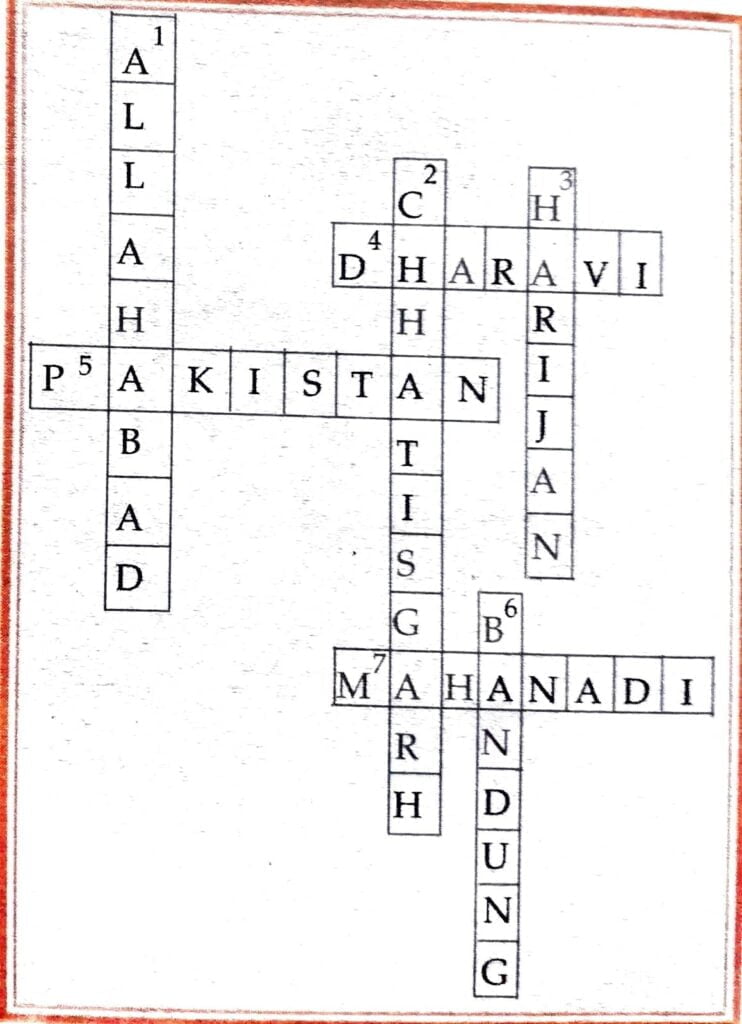
C. Write ‘T’ for true statements and ‘F’ for false ones.
1. Untouchables face violence and discrimination.
Ans. T
2. By the 1970, only two countries had joined the non- aligned.
Ans. F
3. India is still a democratic nation.
Ans. T
4. India gained freedom soon after the devastation of the Second World War.
Ans. T
5. Mira Behn was Mahatma Gandhi’s daughter.
Ans. F
6. States Reorganization Commission was against the formation of compact provinces of Assamese, Bengali, Oriya, respectively.
Ans. F
1. Read the source given and answer the following questions:
Nehru on the Five Year Plan
Prime Minister Jawaharlal Lal Nehru was a great supporter of the planning process. He explained the ideals and purposes of planning in a series of letters he wrote to the Chief Ministers of the different states. In a letter of 22 December 1952, he said that “. behind the First Five Year Plan lies the conception of India s unity and of a mighty cooperative effort of all the peoples of India” We have to remember always that it is not merely the governmental machinery that counts in all this, but even more so the enthusiasm and co-operation of the people captures the imagination of the people.
Q.1. How did Nehruji express his ideals and purposes of planning?
Ans. Nehruji expressed his ideals and purposes of planning in a series of letters he wrote to the chief minister of different states.
Q.2. What importance was laid by Nehruji in the First Five Year Plan?
Ans.Behind the First Five Year Plan lies the conception of India’s unity and of mighty cooperative effort of all the people India.
Q.3. What did Nehruji expect from the people of India?
Ans.Nehruji wanted Indians to work with enthusiasm and full cooperation with each other.
PICTURE BASED QUESTION
Q.1. Look at the picture and the following questions:

1. Whose ashes are being immersed in the picture?
Ans. Mahatma Gandhi ashes were being immersed in the picture.
2. When was he assassinated?
Ans. He was assassinated on 30 January, 1948.
3. By whom was he assassinated?
Ans. He was assassinated by a Frantic Northern Godse.
4. Why did he assassinated him?
Ans. He assassinated him because he disagreed with Gandhiji conviction that Hindu’s and Muslim should live together in harmony.
5. What statement did Jawaharlal Nehru make on this occasion?
Ans. Jawaharlal Nehru made the following statement:
“Friends and comrades, the light has gone out of our lives and there is darkness every where _______ Our beloved leader ________ Father of the Nation is no more.”
Q.2. Look at picture and answer the following questions:
1. Who is the great leader shown with Jawaharlal Nehru in the picture?
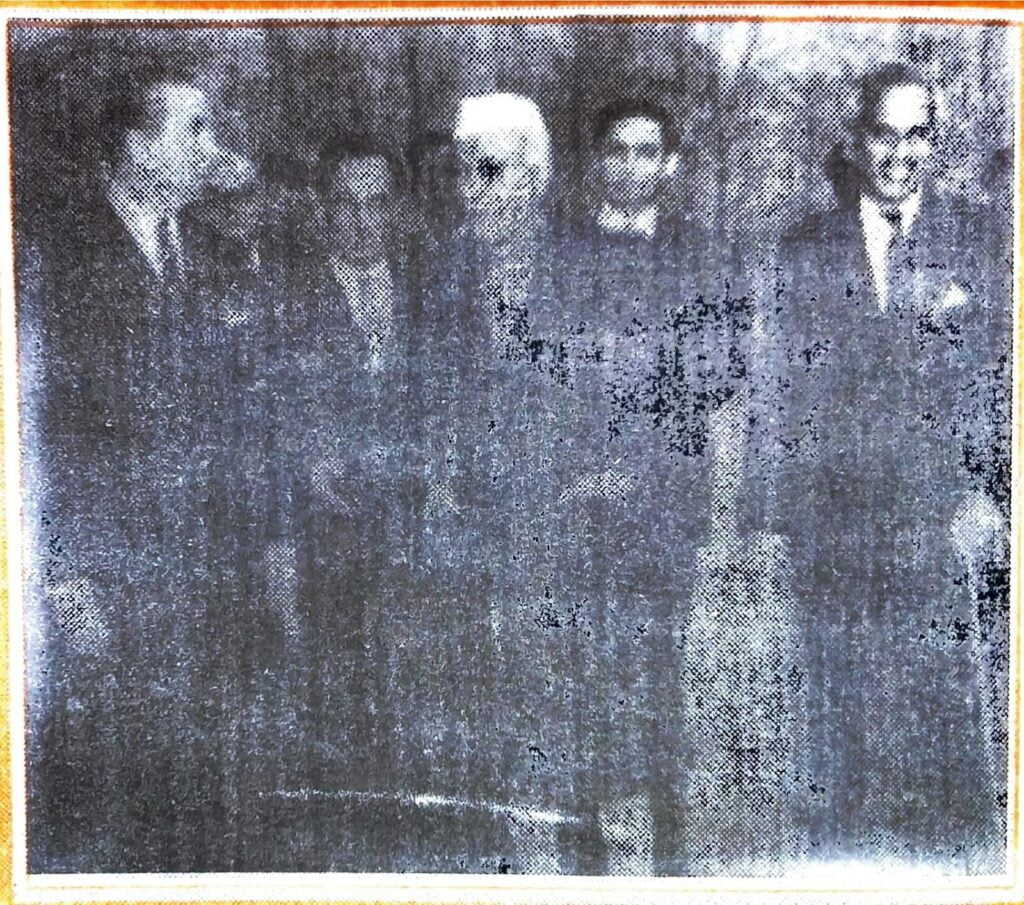
Ans. Krishna Menon is the great leader shown with Jawaharlal Nehru in the picture.
2. What special work did he do at the United Nations?
Ans. He led the Indian delegation to the UN between 1952 and 1962 and argued for a policy of non-alignment.
ACTIVITY
1. Imagine that you are a British administrator leaving India in 1947. You are writing a letter home where you discuss what is likely to happen to India without the British.
Ans. Since we, the British are leaving India now after a period of around 200 years. Since Indians are hard working and India is endowed with vast natural resources, I find a bright future of India.
However, since India’s population is very large with diversities of dress, food and languages, Indians would face the problem of keeping themselves united. Moreover, they will have to strive hard so that unity and development should go hand to hand.
2. Discuss in your class one advantage and one disadvantage today of the decision to keep English as a language of India.
Ans. 1. Advantage: English is a universal language. Keeping English as a language of India would help easy communications in the courts, the services and communications between one state and another.
2. Disadvantage: To keep English as a language of India, means still keeping association with the British. The place of English should be taken by Hindi.

Hi! my Name is Parimal Roy. I have completed my Bachelor’s degree in Philosophy (B.A.) from Silapathar General College. Currently, I am working as an HR Manager at Dev Library. It is a website that provides study materials for students from Class 3 to 12, including SCERT and NCERT notes. It also offers resources for BA, B.Com, B.Sc, and Computer Science, along with postgraduate notes. Besides study materials, the website has novels, eBooks, health and finance articles, biographies, quotes, and more.


